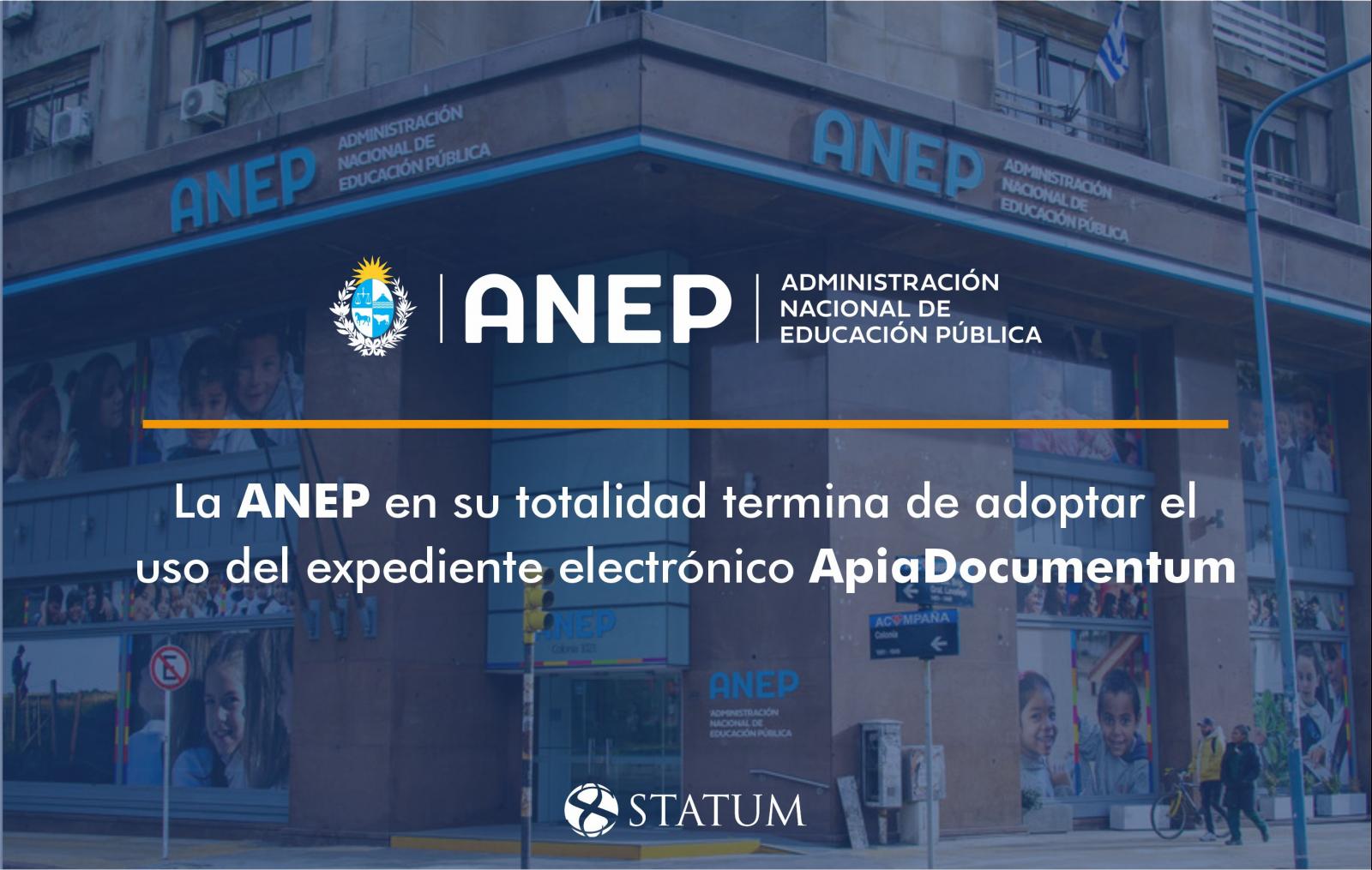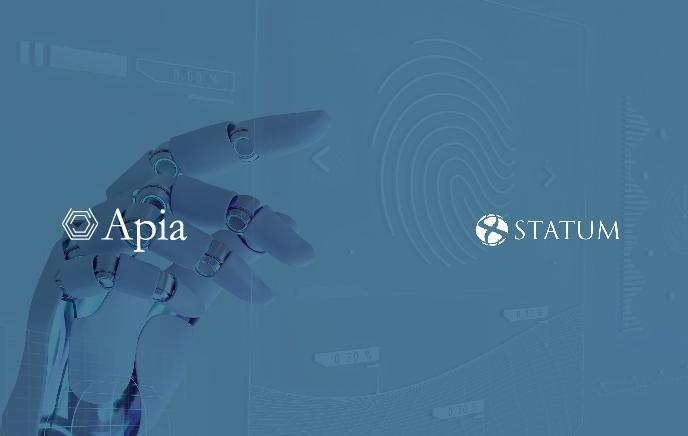La ANEP en su totalidad termina de adoptar el uso del expediente electrónico Apiadocumentum
RESUMEN:
Desde el año 2013, STATUM comenzó su relacionamiento con la administración nacional de educación pública (ANEP) de Uruguay, quien adquirió Apiadocumentum para la gestión de expedientes y trámites electrónicos para el consejo directivo central (CODICEN) siendo utilizado por 3.800 personas.
PROBLEMA:
A partir de dicha implantación, considerando los beneficios que aportaba la misma, con el pasar del tiempo y viendo los beneficios que aportaba su uso así también como las ventajas para interoperar sin papel entre las distintas unidades ejecutoras, se fueron sumando las mismas. Fue así que en el año 2015 se incorporó el Consejo de Formación en Educación (CFE), en el año 2018 se incorporó a la Dirección General de Educación Técnico Profesional (UTU), en el año 2021 se incorporó la Dirección General de Educación Inicial y Primaria (DGEIP) y en el Consejo de Educación Secundaria (CES) finalizando con ello la implantación en todas sus unidades ejecutoras.
A la fecha, la aplicación es utilizada por más de 3.800 funcionarios distribuidos geográficamente en todo el país, habiendo alcanzado la implementación de un centro de implantación de mejoras y soporte interno en ApiaDocumentum para todos los funcionarios del organismo. Con la implantación en el CES, la ANEP logra su objetivo de cobertura integral e interoperabilidad entre todas las unidades ejecutoras, eliminado drásticamente el uso de papel e incrementando la eficiencia en los distintos procesos de tramitación implementados en la herramienta.
HISTORIA:
Hasta 2013, la ANEP, que es el organismo estatal responsable de la planificación y gestión del sistema educativo público del país, utilizaba procesos con papeles, que ocasionaron inconvenientes para rastrearlos y seguirlos.
La idea pensada por las autoridades de estimular un gobierno electrónico busca un vínculo más estrecho entre el individuo y los órganos gubernamentales, sumado a un buen funcionamiento interno gracias al apoyo de la tecnología.
Otro de los inconvenientes que presentaban fue que, cuando sus expedientes querían moverse de un organismo público a otro, era muy dificultoso hacerlo por los canales tradicionales.
Antes de llegar a un acuerdo con Statum, ANEP tenía un funcionario del Banco Interamericano de Desarrollo, que se encargaba de crear y hacer funcionar el sistema. Las autoridades empezaron a entender que si querían tener un ecosistema “que trascendiera el tiempo”, y pudiese ir expandiéndose en cada uno de los organismos que los integraban, debían tener un servicio de calidad.
Como la misión de la ANEP es educar y no ser una “software factory”, encontrar una plataforma que pudiese lograr sus objetivos de manera asequible y poderosa era una necesidad imperiosa. “No teníamos la persona con la calificación necesaria para implementar eso. Tampoco la vamos a tener en el futuro porque los objetivos nuestros son otros”, indicó.
SOLUCIÓN:
Si bien algunas de las consultoras que ofrecían tecnologías de este tipo podrían ser muy eficientes, Pedro Salvetto, consultor del organismo público, le preguntó a Statum si les interesaba participar de una licitación para implementar una solución efectiva de gobierno electrónico. Como los conocía desde 1998 por otros proyectos, y recordaba al detalle la forma de trabajo de la compañía, entendió que era una buena oportunidad. “Estaban muy interesados”, comentó Salvetto.
En el llamado, Statum presentó a Apia. Salvetto siempre supo que era la mejor opción en cuanto al precio y a las funciones que proporcionaba. De esa forma, comenzaron un largo trabajo con los organismos educativos uruguayos que existen dentro de la administración.
El primer hito lo lograron el 18 de febrero de 2013. Allí se puso en marcha el expediente electrónico en el Consejo Directivo Central (Codicen), el órgano que dirige la ANEP.
La incorporación de los distintos organismos al sistema de Statum fue progresiva a lo largo de los años. El 8 de junio de 2015, el Consejo de Formación en Educación, que tiene como cometido la formación de profesionales de la educación, adoptó Apia.
El 20 de noviembre de 2018 fue el turno del Consejo de Educación Técnico Profesional (CETP-UTU), la principal institución pública que imparte educación técnico-profesional, mientras que el 1° de junio fue el turno de la Dirección General de Educación Secundaria. El pasado 19 de julio de 2021 se completó el ciclo: la Dirección General de Educación Inicial y Primaria incorporó la tecnología de Statum.
“Con esto quedó toda la ANEP dentro del expediente electrónico”, indicó Salvetto.
La experiencia del consultor con Statum fue integrarlos al equipo de trabajo de ANEP para hacerlos partícipes de todo el proceso de adopción de la nueva tecnología. “Eso logró un éxito rotundo en la implantación del sistema. Fue realmente buenísimo”, declaró. De hecho, la Agencia del Gobierno Electrónico y Sociedad de la Información (Agesic) lo tomó como un “caso de éxito” que luego tomó como referencia para aplicarlo en otros ámbitos del Estado uruguayo.
La gran solución que encontraron fue estar “donde está todo el mundo”, agregó Salvetto. Esto quiere decir que una buena parte de los organismos del Estado cuentan con Apia.
En el futuro, prevén seguir trabajando en conjunto para implementar procesos internos que hasta ahora no habían utilizado.
BENEFICIOS:
La implementación trae consigo una mayor transparencia y acceso. Los usuarios que utilizan el sistema pueden conocer en qué oficina o lugar está el expediente y la última fecha que se actualizó.
Este sistema implementado por Statum favorece el pasaje rápido, automático e inmediato de una oficina a la otra. Permite identificar el trabajo realizado y lo que queda pendiente.
A su vez, reduce el riesgo de que se deteriore o extravíe un expediente ya que no se utiliza el papel y que exista una persona que traslade el documento. Este sistema también genera una mayor dificultad de adulteración de los documentos.
El beneficio también se observa en los costos. Salvetto afirmó que hoy “ya no hay necesidad de imprimir un solo papel para enviar un expediente”. Además, ha permitido cumplir con plazos. Uno de ellos es el que establece la ley de acceso a la información pública, que exige 20 días hábiles para enviar datos solicitados por un ciudadano. Apia “agiliza” y además “da las garantías adecuadas” para cumplir con lo solicitado.
Apia otorga beneficios como la trazabilidad de los expedientes y analizar la productividad. “La seguridad de que no se va a poder alterar, vos un expediente papel le podés sacar una hoja y sustituirla por otra.
Sin ningún problema. Entonces, esto es mucho más seguro y confiable”, indicó.
Esa mayor trazabilidad también permite detectar quién se pudo haber equivocado en el movimiento de un expediente. “Con el papel vos te equivocás y de repente ese error no se visualiza, no se ve. Acá vos te podés equivocar, pero está toda la traza, se pueden reconstruir todas las situaciones”, agregó el experto. Y, por sobre todas las cosas, se puede observar la productividad de los funcionarios.
La tecnología de Statum permite auditar y analizar si todos los procedimientos se están cumpliendo de manera adecuada o no.
Con la plataforma de Statum, la ANEP ya se encuentra interoperando con otros organismos estatales.
ApiaDocumentum es la solución líder para la gestión de los expedientes, trámites y documentos digitales en el Sector Público (Gobierno) que permite automatizar de forma rápida y efectiva todos los trámites de una organización eliminado el uso de papel. En Uruguay, +80% de los organismos públicos cuenta con ApiaDocumentum para su gestión interna y el intercambio digital de los documentos con otras instituciones públicas eliminando la impresión y traslado físico de los documentos. ApiaDocumentum funciona sobre la plataforma Apia BPMS utilizando las mejores prácticas de la Gestión por Procesos y Gestión Documental.
- Información en Template: Click aquí
Material de interés relacionado:
Toda la ANEP está comprendida dentro del Sistema de Expediente Electrónico
ANEP sigue apostando a ApiaDocumentum
Manuales APIA 2.2
Login en sitio de la Administración Nacional de la Educación Pública





Comentarios (0)
Deja un comentario